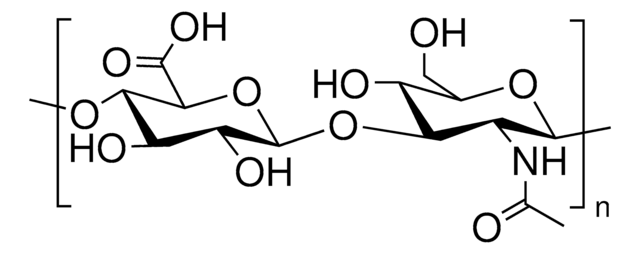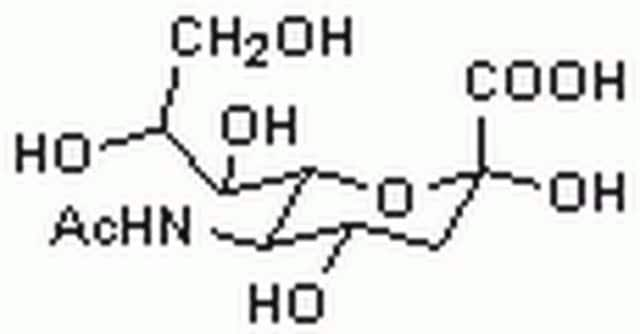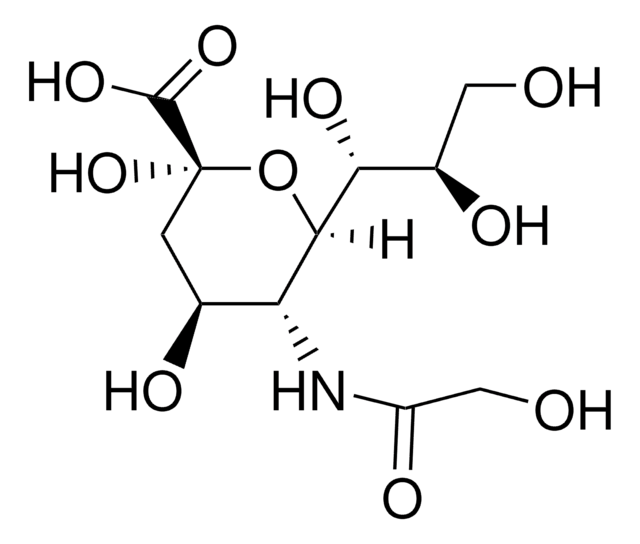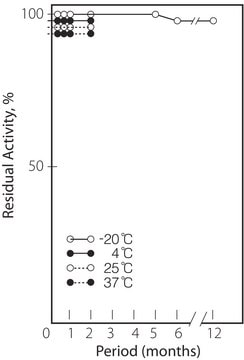Products may be shipped at a different temperature than the recommended long-term storage temperature. If the product quality is sensitive to short-term exposure to conditions other than the recommended long-term storage, it will be shipped on wet or dry-ice. If the product quality is NOT affected by short-term exposure to conditions other than the recommended long-term storage, it will be shipped at ambient temperature. As shipping routes are configured for minimum transit times, shipping at ambient temperature helps control shipping costs for our customers. For more information, please refer to the Storage and Transport Conditions document: https://www.sigmaaldrich.com/deepweb/assets/sigmaaldrich/marketing/global/documents/316/622/storage-transport-conditions-mk.pdf
A2388
N-Acetylneuraminic acid
≥98% (HPLC), from Escherichia coli
Sinónimos:
5-Acetamido-3,5-dideoxy-D-glycero-D-galactononulosonic acid, Lactaminic acid, NAN, NANA, Sialic acid
Seleccione un Tamaño
Seleccione un Tamaño
About This Item
Productos recomendados
origen biológico
Escherichia coli
tpo
Type VI
Ensayo
≥98% (HPLC)
Formulario
powder
actividad óptica
[α]20/D -34.0 to -30.0 °, c = 1% in water
técnicas
HPLC: suitable
color
white to off-white
mp
184-186 °C
solubilidad
water: 50 mg/mL, clear, colorless
temp. de almacenamiento
−20°C
cadena SMILES
O[C@@]1(O[C@@]([C@@H]([C@H](C1)O)NC(C)=O)([H])[C@@H]([C@@H](CO)O)O)C(O)=O
InChI
1S/C11H19NO9/c1-4(14)12-7-5(15)2-11(20,10(18)19)21-9(7)8(17)6(16)3-13/h5-9,13,15-17,20H,2-3H2,1H3,(H,12,14)(H,18,19)/t5-,6+,7+,8+,9+,11-/m0/s1
Clave InChI
SQVRNKJHWKZAKO-PFQGKNLYSA-N
¿Está buscando productos similares? Visita Guía de comparación de productos
Aplicación
Acciones bioquímicas o fisiológicas
Otras notas
Palabra de señalización
Warning
Frases de peligro
Consejos de prudencia
Clasificaciones de peligro
Eye Irrit. 2
Código de clase de almacenamiento
11 - Combustible Solids
Clase de riesgo para el agua (WGK)
WGK 2
Punto de inflamabilidad (°F)
Not applicable
Punto de inflamabilidad (°C)
Not applicable
Equipo de protección personal
Eyeshields, Gloves, type N95 (US)
Elija entre una de las versiones más recientes:
Certificados de análisis (COA)
¿No ve la versión correcta?
Si necesita una versión concreta, puede buscar un certificado específico por el número de lote.
¿Ya tiene este producto?
Encuentre la documentación para los productos que ha comprado recientemente en la Biblioteca de documentos.
Los clientes también vieron
Protocolos
Enzymatic Assay of Neuraminidase applies to products that have a specification for neuraminidase content by enzymatic determination.
-
How is shipping temperature determined? And how is it related to the product storage temperature?
1 answer-
Helpful?
-
-
How can I determine the shelf life / expiration / retest date of this product?
1 answer-
If this product has an expiration or retest date, it will be shown on the Certificate of Analysis (COA, CofA). If there is no retest or expiration date listed on the product's COA, we do not have suitable stability data to determine a shelf life. For these products, the only date on the COA will be the release date; a retest, expiration, or use-by-date will not be displayed.
For all products, we recommend handling per defined conditions as printed in our product literature and website product descriptions. We recommend that products should be routinely inspected by customers to ensure they perform as expected.
For products without retest or expiration dates, our standard warranty of 1 year from the date of shipment is applicable.
For more information, please refer to the Product Dating Information document: https://www.sigmaaldrich.com/deepweb/assets/sigmaaldrich/marketing/global/documents/449/386/product-dating-information-mk.pdfHelpful?
-
-
I was wondering if the Sigma-Aldrich (A2388) N-Acetylneuraminic acid from Escherichia coli, ≥98%, is suitable to use in vitro on oligodendrocytes. In other words, is it sterile? Thank you in advance.
1 answer-
This product has not been tested for in vivo or in vitro applications. Suitability for in vitro use will need to be validated by the end-user. The material is purified from Escherichia coli and has not tested for endotoxin. Solutions would require sterile filtration prior to adding to cultures. Alternatively, product 110138 is a synthetically produced product option. While not tested for in vitro use, it may be a better option for sensitive cell lines. It is not sterile and solutions would also required filter sterilization. See the link below to review this product:
https://www.sigmaaldrich.com/product/mm/110138Helpful?
-
Active Filters
Nuestro equipo de científicos tiene experiencia en todas las áreas de investigación: Ciencias de la vida, Ciencia de los materiales, Síntesis química, Cromatografía, Analítica y muchas otras.
Póngase en contacto con el Servicio técnico












